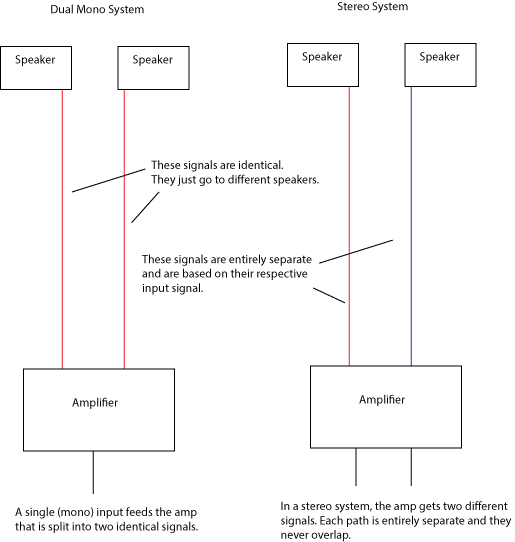You are currently viewing a course sample, but you’re not yet a member! Only certain modules will be available to you. To sign up for a membership to access the full course, check out our Plans and Pricing or Login
In order to get a sound system setup and working, it’s important to understand what connectors and cables to use. Cables are like the veins that connect a system together. Without them all your gear is totally worthless because each piece has no way of sending or receiving signal.
Sometimes using the wrong cable won’t matter, sometimes it can add noise, and sometimes it can actually break something. So as we prepare to understand how a sound system works, we first need to understand how all the pieces and parts hook together.
Stereo and Mono
Before we get into all the variety of cables and connectors, it’s important to understand the difference between a stereo signal and a mono signal. Most of the audio carrying signals you work with in pro audio are either stereo or mono. In the old days, all sound systems were mono. A mono system only has a single signal. For example, if you had a PA system set up with a single speaker, you would be operating in mono.
A speaker system that has two speakers with separate signals going to each one is a stereo system. Most headphones are stereo. The signals that go to each ear are entirely separate allowing the mix engineer to control the how different sounds are perceived spatially. By changing the amount of each instrument in each ear, a mix engineer can make instruments sound as if they are actually in different locations within a room. When you hear a person talk, you instantly know where they are coming from. A stereo mix allows an engineer to create a similar effect by adjusting the amount of audio going to each channel. By adjusting with the position of the instruments in the mix, it can cause us to perceive an instrument in a different space.
Some systems are “dual mono” meaning that they have two speakers, but both signals are carrying the same signal. This doesn’t allow the engineer to adjust each instrument individually in each speaker. The above diagram illustrates the differences between the two setups. It’s important to note that just because a speaker system has two (or more speakers), it isn’t necessarily stereo. It also needs to have a separate signals going to each speaker.
Many PA systems today are stereo capable, although a mono PA system is still common. Understanding the difference allows us to determine how to setup and adjust a mix.
If two (or more speakers) are wired together, they are typically wired in series. We’ll talk more about series and parallel wiring later when we get to the section on speakers. For now, just understand that if you daisy chain two speakers together, they are still carrying a mono signal and not a stereo signal.
XLR Connectors
The XLR cable is one of the most common cables in a typical sound reinforcement setup. It is an industry standard for carrying a balanced audio signal. We’ll talk more about balanced and unbalanced a little later.
Most microphones have XLR connectors. Because of the signal is balanced, it can travel farther without introducing significant noise to the signal. Below is an image of a male XLR connector.
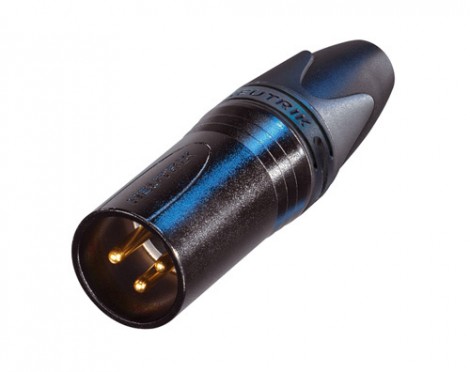
Image courtesy of Neutrik
In technical vernacular, a male connector is the one that has the pins. Male connectors always plug into female connectors. If you’re wondering why they are called male and female, you should ask your mom. I’m sure she has a great explanation for you.
¼in Connectors (TS and TRS Connectors)
Probably the most common type of connector in live sound is the TS connector. Also known a ¼ inch connector, this connector is often used on guitars, keyboards, bass guitars, and a variety of other instruments.
In addition, some speakers accept a 1/4in cable input. Although the cable type is different the connector is often the same (stick with us until the end of the module to understand the difference between line and speaker level signals).
¼in connectors come in both a TS and TRS configuration. TS stands for Tip-Sleeve. TRS stands for Tip-Ring-Sleeve. Although these connectors look identical at first, there is one distinct difference. Take a look:
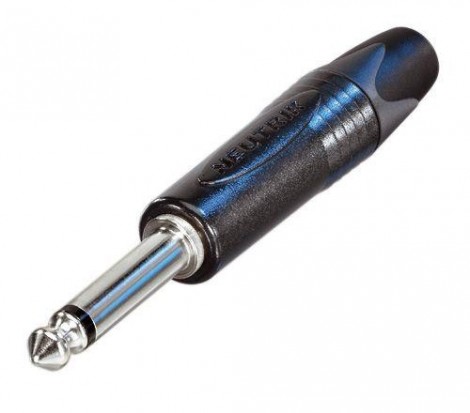
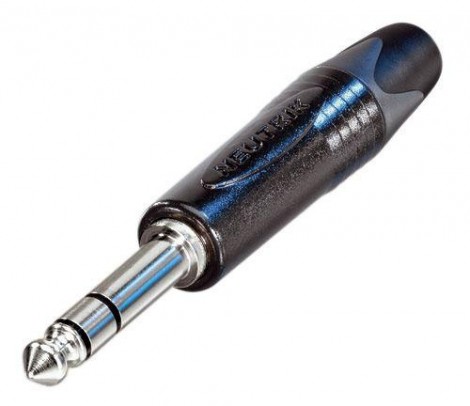
Both images courtesy of Neutrik
As you can see, TS connectors don’t have the extra ring around the middle whereas TRS cables do. TRS cables can carry a balanced signal while TS cables cannot. In addition, sometimes the TRS cables are used to carry stereo unbalanced signals. Many studio quality headphones have a TRS connector. This allows them to carry two separate signals – one for each ear.
Just because a device has a 1/4 inch connector doesn’t mean that they can all get hooked up together. Sending a speaker level signal (out of an amplifier) to a line level input will damage the gear. Additionally, sending a line level output to a speaker will not have nearly enough power to drive the speaker. Because these connectors are so common, it is easy to accidentally connect two pieces of gear that shouldn’t be connected. Understanding not only the connectors, but also the types of signal is important when setting up your system.
NL4 (Speakon) Connectors
NL4 connectors are used almost exclusively to connect amplifiers to speakers. They lock in place to prevent accidental removal if someone trips or steps on the cable. They also do not have exposed pins making them able to carry higher power signals more safely than traditional 1/4 inch connectors. They are a popular speaker connector and are used in mid and high level gear.
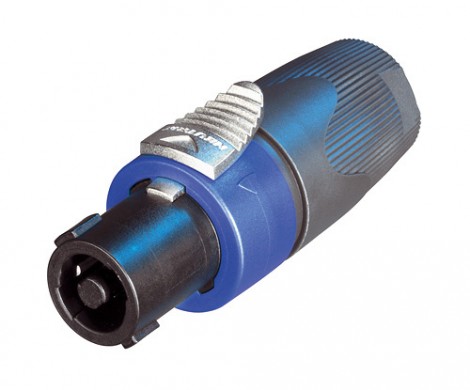
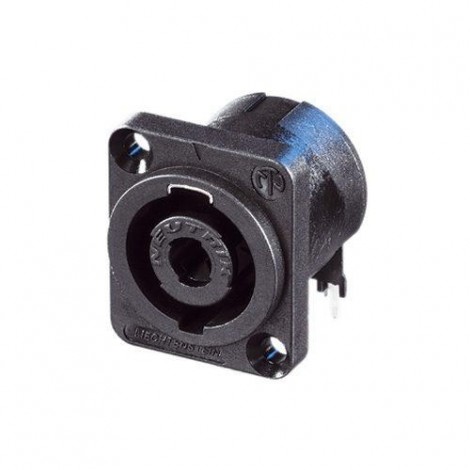
Both images courtesy of Neutrik
MIDI (Musical Instrument Digital Interface) Connectors
One type of cable occasionally used to transmit digital signal is a MIDI cable. MIDI cables do not transmit audio, but instead transmit a control signal. You will usually find them attached to electronic instruments and can be used to help automate changes on some high-end digital consoles. They typically have 5 pins (although 7 pin versions do exist). Although that’s all we’ll say about them here, you should know what they look like so you do not confuse them with any other type of cable.
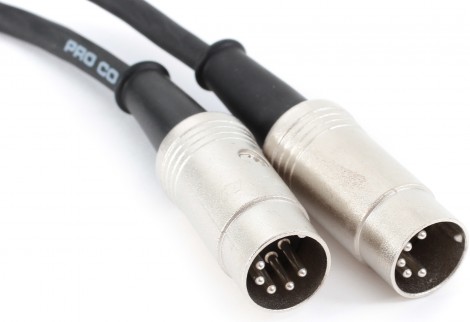
Image courtesy of Sweetwater Sound
1/8in Connectors
These connectors are often known as 3.5 mm Similar to the ¼in cables, these come in TS and TRS configurations. Although these aren’t extremely common in pro audio setups, they are seeing more and more use as iPod and MP3 players become more a standard for music playback. A typical ⅛ TRS connector is the connector on your earbuds or the jack in your iPhone. Few consoles have a 1/8 inch input, so usually one end of the cable will be a 1/8 TRS while the other end is usually two 1/4 in TS connectors or RCA connectors.
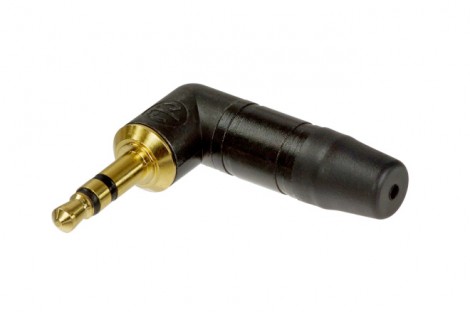
Image courtesy of Neutrik
RCA Connectors
RCA connectors are still common on many sound systems. RCA connectors (also known as phono connectors) are found on many CD players, DVD players, VCRs, and other consumer electronics. They allow consumer equipment to interface with pro audio equipment easily. They often come in a pair with one red and one white connector per cable. Red is for the right channel and white is for the left channel on a stereo setup. Occasionally you’ll see these cables with three or five to a cable. If there are more than two connectors, the other colored RCA cables are usually designed carry video rather than audio signals and should (likely) be ignored if you’re just trying to setup the sound system.
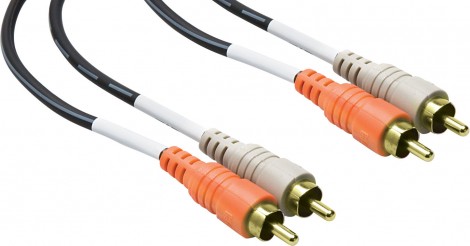
Image courtesy of Sweetwater Sound
[kkstarratings]